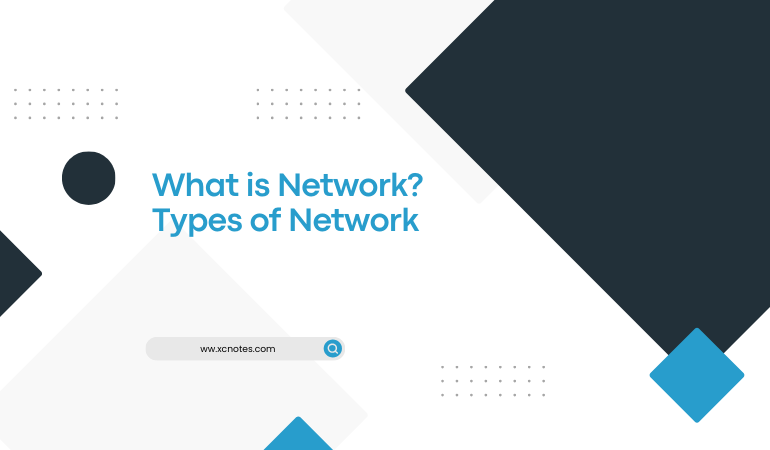
What is Network? Types of Network
In the context of technology and computing, a network refers to a collection of devices, such as computers, servers, printers, and other peripherals, that facilitate communication and data sharing. Networks allow devices to exchange information, resources, and services, enabling collaboration and efficient data transfer. Networks are essential for communication, data transfer, and resource sharing between various devices, such as computers, smartphones, servers, and other network-enabled devices. In the context of technology and computing, a network refers to a collection of devices, such as computers, servers, printers, and other peripherals, that facilitate communication and data sharing. Networks allow devices to exchange information, resources, and services, enabling collaboration and efficient data transfer.
There are several types of networks, each serving different purposes and catering to specific needs.
The types of Networks are:
Local Area Network (LAN): A LAN is a network that covers a small geographic area, such as an office building, school, or home. It allows devices in close proximity to communicate and share resources(like printers). LANs are typically used for connecting computers, printers, and other devices within a limited area. They are usually connected using wired Ethernet or wireless Wi-Fi technologies.
Example: An office network where computers are connected to each other for file sharing, printer access, and local resource sharing.
Wide Area Network (WAN): A WAN spans larger geographical areas, such as cities, countries, or even continents. It connects multiple LANs or other WANs together using routers and telecommunications links. The internet itself is an example of a global-scale WAN. WANs utilize routers, switches, leased lines, or public networks (such as the Internet) to establish connections between different locations. WANs are often used by organizations with branches in different cities or countries.
Example: The internet itself is a global WAN that connects computers and networks worldwide, allowing communication and data exchange on a global scale.
Metropolitan Area Network (MAN): A MAN covers a larger area than a LAN but is smaller in scale compared to a WAN(It is larger in scale than a Local Area Network (LAN) but smaller than a Wide Area Network (WAN).). It typically spans a city or metropolitan region, connecting multiple LANs or other network infrastructure. A MAN is a network that spans a city or a metropolitan area. It provides connectivity between various LANs and can be operated by a single organization or multiple service providers. MANs are commonly used to interconnect buildings or campuses within a city.
Example: A cable TV network that offers internet access to subscribers across a city.
Wireless Network: A wireless network enables devices to connect and communicate without the need for physical cables(like Ethernet etc). Wi-Fi networks, for example, use wireless access points to provide network connectivity to devices within a certain range. Wireless networks use wireless signals, such as Wi-Fi, Bluetooth, or cellular networks, to establish connections between devices without needing physical cables. They provide flexibility and mobility, allowing devices to connect to a network without being physically tethered.
Example: A coffee shop providing wireless internet access to customers within its premises.
Campus Area Network (CAN): A CAN is a network that covers a university campus, corporate office complex, or any large-scale area where multiple LANs are interconnected. A campus network is typically found in educational institutions or large organizations. It interconnects various buildings within a specific area, such as a university campus or corporate headquarters, providing communication and resource sharing among different departments or entities.
Example: A university network that interconnects academic buildings, libraries, administrative offices, and dormitories.
Storage Area Network (SAN): A SAN is a specialized network that provides high-speed access to shared storage devices, such as disk arrays or tape libraries. SANs are commonly used in data centers and enterprise environments.
Example: A data center where multiple servers access a central storage system for storing and retrieving data.
Virtual Private Network (VPN): A VPN is a secure network that allows remote users to connect to a private network over the public internet. It provides encrypted communication and enhances security for remote access. A VPN is a secure network that allows remote users or branch offices to connect to a private network over a public network, such as the Internet. VPNs encrypt data to ensure privacy and security, enabling users to access resources on the private network as if they were directly connected to it.
Example: Employees accessing their company’s internal network securely from a remote location using a VPN client.
Intranet and Extranet: An intranet is a private network that utilizes Internet technologies to share information and resources within an organization. An extranet, on the other hand, extends the intranet’s accessibility to authorized external parties, such as suppliers, partners, or customers.
Peer-to-Peer Network (P2P): In a P2P network, devices are connected directly to each other without the need for a centralized server. Each device can act as both a client and a server, allowing users to share files, resources, or services directly with other devices in the network.
These are just a few examples of network types, and there are many other specialized networks, such as industrial control networks, home networks, and more. The choice of network type depends on factors such as the scale of the network, geographical coverage, security requirements, and specific applications or services being provided.


